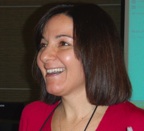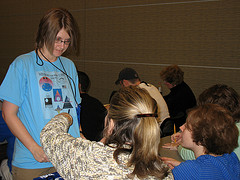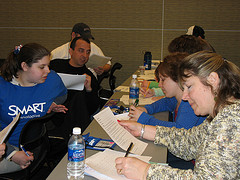Everyday Science Mysteries: Stories for Inquiry-Based Science Teaching
What causes condensation? Does temperature affect how well a balloon will fly? How do tiny bugs get into oatmeal? Through 15 mystery stories, this book memorably illustrates science concepts for students and reinforces the value of learning science through inquiry. Each mystery presents opportunities for students to create questions, form hypotheses, test their ideas, and come up with explanations.
What causes condensation? Does temperature affect how well a balloon will fly? How do tiny bugs get into oatmeal? Through 15 mystery stories, this book memorably illustrates science concepts for students and reinforces the value of learning science through inquiry. Each mystery presents opportunities for students to create questions, form hypotheses, test their ideas, and come up with explanations.



 Well, this conference is history, and I’m exhausted in a good way— both physically and mentally. From talks by astronaut Barbara Morgan, Rodger Bybee, and Bill Nye the Science Guy to the awesome resources in the exhibit area to the sessions in which educators so generously shared their experiences and expertise, it was a great event. Thanks to all who planned this! Of course there were a few glitches (such as a shuttle bus driver new to Boston who unexpectedly gave us a roundabout tour of the city), and the sheer size of the conference center and the surrounding hotel area was daunting, but I’m sure that all of the more than 15,000 (so I’m told) attendees found new ideas and resources for their classes and schools. I hope that they found time to soak up a little Boston history and culture, too.
Well, this conference is history, and I’m exhausted in a good way— both physically and mentally. From talks by astronaut Barbara Morgan, Rodger Bybee, and Bill Nye the Science Guy to the awesome resources in the exhibit area to the sessions in which educators so generously shared their experiences and expertise, it was a great event. Thanks to all who planned this! Of course there were a few glitches (such as a shuttle bus driver new to Boston who unexpectedly gave us a roundabout tour of the city), and the sheer size of the conference center and the surrounding hotel area was daunting, but I’m sure that all of the more than 15,000 (so I’m told) attendees found new ideas and resources for their classes and schools. I hope that they found time to soak up a little Boston history and culture, too. So, you’re a presenter and your time slot is the last one of the conference, and your room is the farthest from the lobby. Will anyone come? In the case of Sami Kahn’s presentation on Wikis in the elementary classroom, she didn’t have to worry! Those of us who attended (and there were quite a few) were treated to some excellent modeling (or should I say Moodle-ing) of how these tools can be used by actual 4th-graders. A lot of teachers are not keen on their students using Wikipedia as their main source of information. But Sami described a project in which her students at the Collegiate School in New York City create their own Wiki related to their annual “invention convention” showcase. The Wiki is limited to her students, and she is notified whenever any changes are made. She showed us some entries that were created while she was here at the conference. Her younger students are
So, you’re a presenter and your time slot is the last one of the conference, and your room is the farthest from the lobby. Will anyone come? In the case of Sami Kahn’s presentation on Wikis in the elementary classroom, she didn’t have to worry! Those of us who attended (and there were quite a few) were treated to some excellent modeling (or should I say Moodle-ing) of how these tools can be used by actual 4th-graders. A lot of teachers are not keen on their students using Wikipedia as their main source of information. But Sami described a project in which her students at the Collegiate School in New York City create their own Wiki related to their annual “invention convention” showcase. The Wiki is limited to her students, and she is notified whenever any changes are made. She showed us some entries that were created while she was here at the conference. Her younger students are  Sunday morning is a tough time for a presenter. Early departures, church services, brunch dates, or too much Saturday evening make it difficult for some to attend sessions at this time. I’m sure that Michael Barnett from Boston College was pleased to see a nice crowd at his session on “Using GIS to Model Urban Street Value.” He demonstrated a program that starts with a satellite image of an area. The students add the location of trees, buildings, parking lots, and grassy areas. He provided us with laptops to see the actual maps created by the students and then we ran an analysis program that calculated a summary of the economic benefit of the trees. But the really cool part was that the model could be modified to answer questions such as What happens if we plant more trees? Are some species of trees more beneficial than others? What happens if we pave over a grassy area to make a parking lot? Check out the
Sunday morning is a tough time for a presenter. Early departures, church services, brunch dates, or too much Saturday evening make it difficult for some to attend sessions at this time. I’m sure that Michael Barnett from Boston College was pleased to see a nice crowd at his session on “Using GIS to Model Urban Street Value.” He demonstrated a program that starts with a satellite image of an area. The students add the location of trees, buildings, parking lots, and grassy areas. He provided us with laptops to see the actual maps created by the students and then we ran an analysis program that calculated a summary of the economic benefit of the trees. But the really cool part was that the model could be modified to answer questions such as What happens if we plant more trees? Are some species of trees more beneficial than others? What happens if we pave over a grassy area to make a parking lot? Check out the 


 This session prepared us to lead a one-week unit in which students take a “journey” to the Moon. Facilitators Tara Clopper and Heather Slatoff led us in hands-on activities, including designing our own mission patches. One perk with this session—a free CD containing the whole unit, including video clips.
This session prepared us to lead a one-week unit in which students take a “journey” to the Moon. Facilitators Tara Clopper and Heather Slatoff led us in hands-on activities, including designing our own mission patches. One perk with this session—a free CD containing the whole unit, including video clips. During a mission communication activity, teacher teams played the roles of “senders” and “receivers.” Senders shaded squares on a grid and tried to convey the design to the receivers without showing them the grid. It reminded me of the game “Battleship,” which was popular when I was in seventh grade.
During a mission communication activity, teacher teams played the roles of “senders” and “receivers.” Senders shaded squares on a grid and tried to convey the design to the receivers without showing them the grid. It reminded me of the game “Battleship,” which was popular when I was in seventh grade. With so much to see and do at the conference, I shouldn’t be surprised by the number of people I see no matter how early I arrive. If there’s a workshop going on, there are people in there.
With so much to see and do at the conference, I shouldn’t be surprised by the number of people I see no matter how early I arrive. If there’s a workshop going on, there are people in there.



